2005 Porsche Gt3 Review
Guide to Buying a Porsche 911 Carrera 997
What You Must Know Before Buying A Used 911 Carrera 997
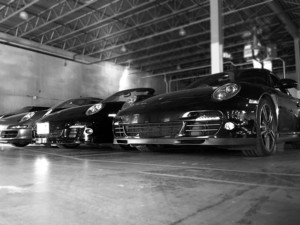 If you're just taking the initial steps to buying a Porsche 911 Carrera 997, this guide will highlight some of the technical issues to be aware of before you commit to buy. The early 997 cars are now extremely affordable and can be fun to own.
If you're just taking the initial steps to buying a Porsche 911 Carrera 997, this guide will highlight some of the technical issues to be aware of before you commit to buy. The early 997 cars are now extremely affordable and can be fun to own.
Finding the right car is never simple, but with some luck and armed with the right information, you can pick up a bargain. 15-year-old cars with reasonable mileage are available for less than 20% of what they cost originally and the 997 is a lot of car!
There is a distinct difference between the early versus the later cars. The 997 version 2 is a significantly revised platform.
How To Tell a Good 997 From a Bad One?
Our guide to buying a used 911 997 will help you find the bargain and avoid the bad investment. There's no fluff or niceties here – there are plenty of resources online that bash on about horse power, cosmetic variants, historical significance and the niceties of the 911 Carrera 997. All well and good, but how do you tell a good mechanical 997 from a bad one? What are the potential pitfalls? What known problems exist and how do you avoid them? We have the answers you need.
We concentrate on the technical things that might cost you money later if you weren't aware of them prior to buying the car. There are risks if you're not cautious, but with some insights and careful shopping, there are bargains to be had.
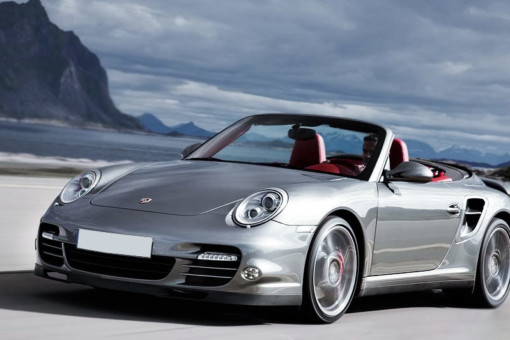
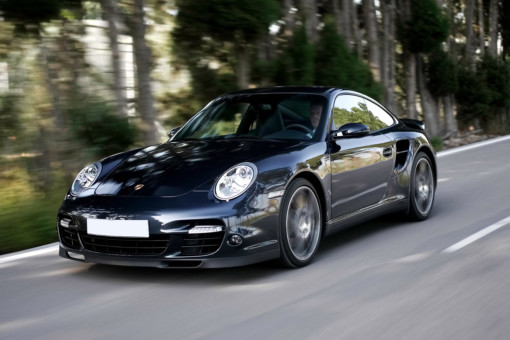
What do we know about the 911 Carrera 997 so far?
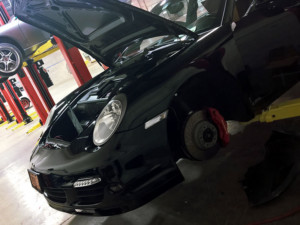 The 911 Carrera 997 was Porsche's second go round at moving on from the air-cooled 911. The car is fun and exhilarating to drive, yet can be used every day. After the success and issues with the 996 versions of the 911, Porsche launched the 997 revised version in 2005. While the 996 was a little rawer, the new 997 was more sophisticated, well behaved and easier to drive.
The 911 Carrera 997 was Porsche's second go round at moving on from the air-cooled 911. The car is fun and exhilarating to drive, yet can be used every day. After the success and issues with the 996 versions of the 911, Porsche launched the 997 revised version in 2005. While the 996 was a little rawer, the new 997 was more sophisticated, well behaved and easier to drive.
During production, which ran until 2013, Porsche produced a number of derivatives that included the Carrera Coupe, S, Targa, Turbo, Cabriolet, 4wd and GT versions. The most significant update came in 2009 with the launch of the 997.2 version.
Good Bye Air Cooled – The Sequel
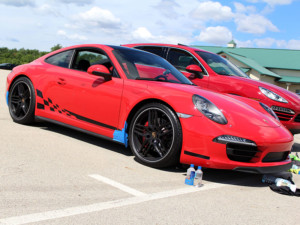 Porsche took what it had learned from the 996 and early 997 revisions and in 2009 launched the updated 997.2. The second version of the 997 made some significant departures from the original 997 including a new direct fuel injected engine (9A1) a dual clutch PDK transmission, revised suspension and the all-important from bumper with LED lights! The 997.2 is probably the first time since the air-cooled cars, that Porsche actually got the 911 in the solid reliable spot it needed to be in.
Porsche took what it had learned from the 996 and early 997 revisions and in 2009 launched the updated 997.2. The second version of the 997 made some significant departures from the original 997 including a new direct fuel injected engine (9A1) a dual clutch PDK transmission, revised suspension and the all-important from bumper with LED lights! The 997.2 is probably the first time since the air-cooled cars, that Porsche actually got the 911 in the solid reliable spot it needed to be in.
The Turbo and GT cars continued to be powered by different engines from the Carrera versions and are exempt from this discussion. The original 997 Carrera featured a M96-05 engine, while the S models got an M97 style engine that addressed some of the problems from the previous M96 versions. The DFI engine, in the newer 997.2, further corrected the problems from the original engines and completely eliminated the famed IMS style design.
997 in the Sweet Spot
The first-generation 911 997 Carrera is now close to 15 years old. The 997 has been well driven, raced, broken, dissembled and put back together again. As a result, there's extensive knowledge available of common mechanical problems with these cars and therefore, it's possible to sort the good used 997 from the bad.
The majority of the car is generally reliable and has a near timeless look. With the launch of a new 992 platform, prices for the 997 have been driven even lower. This is a super value for money, everyday super car that has excellent reliability.
The Missing Years
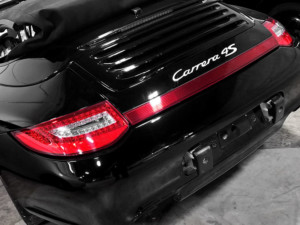 Any 911 from 2008 through 2011 is bit harder to find — If you remember, the economy was in free-fall after the housing bubble burst and the banks stole all our money, our 401K and then took billions of tax Dollars as a bailout gift – not many people rushed out and bought a 911 during this time! Consequently, there is a distinct shortage of available cars between these years. The early 997.2 should be a bargain, but is hard to find – see our article for more detail.
Any 911 from 2008 through 2011 is bit harder to find — If you remember, the economy was in free-fall after the housing bubble burst and the banks stole all our money, our 401K and then took billions of tax Dollars as a bailout gift – not many people rushed out and bought a 911 during this time! Consequently, there is a distinct shortage of available cars between these years. The early 997.2 should be a bargain, but is hard to find – see our article for more detail.
Spare Parts and Repairs
The 911 Carrera 997 is easy to upgrade from both a performance or cosmetic stand point. Many original parts were revised but were reused on the later chassis such as the 991. Most are readily available directly from Porsche and a healthy used parts market exists to fill the gaps. There is also a good deal of experience and expertise in independent Porsche repair shops to help make the maintenance of your used 911 Carrera 997 cost effective.
Maintenance Costs
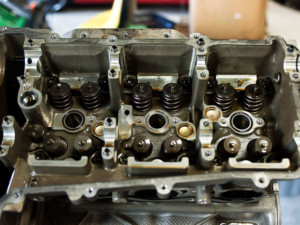 You're buying a Porsche, so don't compare running costs to a small domestic hatchback! Yes, parts and some labor costs will be higher than a typical American or Japanese vehicle. However, save for a few notable items discussed below, the 911 Carrera 997 is solid and reliable. The later versions certainly come with significantly less of the catastrophic engine problems that were experienced in the early 996.
You're buying a Porsche, so don't compare running costs to a small domestic hatchback! Yes, parts and some labor costs will be higher than a typical American or Japanese vehicle. However, save for a few notable items discussed below, the 911 Carrera 997 is solid and reliable. The later versions certainly come with significantly less of the catastrophic engine problems that were experienced in the early 996.
You're going to pay a little more for an oil change and standard maintenance items, however, don't try to cheap these. It's really important to have the car inspected and serviced by a professional with genuine Porsche expertise. A good mechanical understanding of these cars can help identify issues early and save you money in the long term. See our guide to Porsche repair shops for your local expert or contact us and we'll make a recommendation for you.
Maintenance Schedule
It's important to understand where the 997 you're considering buying falls within it's recommended maintenance schedule. Maintenance schedules are based on mileage and elapsed time. On many of the used 997 examples, elapsed time is going to be the most important consideration. Compare the known maintenance history of the 997 with our recommended maintenance schedules. This should enable you to better understand the asking price, the near future maintenance requirements of the car and perhaps help identify a well maintained 997 from a neglected one.
Buying a low mileage 997 and not realizing major maintenance is overdue, is not the smartest thing you can do!
Pre-Purchase Inspection
The first step, once you've identified a 997 candidate, is to get a thorough inspection by a local Porsche expert. The pre-purchase inspection is designed to identify mechanical problems that may not be clearly evident at first glance. In our buyer guide below we've extensively highlighted those potential issues to be on the look out for. Getting a repair history on the car, if available, is helpful and will instantly identify or eliminate potential problem areas.
The number of owners doesn't necessarily matter with a Porsche – the work and records performed do. Many owners are enthusiasts and will keep all the invoices from service or repairs performed.
If a seller wont let you inspect the car, walk away.
Consider who is selling the car. For a private sale you need to know why the vehicle is for sale. If you're buying from a used car dealer, do your research to learn where the dealer got the car. If it's a dealer that specializes in Porsche, well and good. However, if the dealer's normal trade is low cost mini vans, you need to do some serious thinking. Who trades there Porsche for a cheap mini van? The owner that has a serious problem and knows the mini van dealer wont find it?
Mileage and Service History
On cars approaching 15 years old, higher mileage is not necessarily a bad thing. In fact, a 997 Carrera that has been well used, could be in a better condition than one that has an attractively low mileage reading. Low mileage cars can have hidden issues although rarely is the 997 used as a daily driver, so 10,000 per year would be considered higher mileage.
You'll want to take a good look through any documented history available. A clear pattern of servicing on higher mileage cars is essential. If you're considering buying a lower mileage 911 Carrera 997, timed intervals between maintenance is the key thing to look for, regardless of the mileage.
Attractive Low Mileage – not so fast!
It's always great to find a low mileage car, however, the low miles can present a different set of challenges to cars that are designed for 10K miles per year.
Low mile examples often miss their regular service intervals. This can cause time related degradation of the service items to be overlooked. Despite a lack of mileage, wear and tear will take place in fluids, tires, brakes, clutch surfaces and oil seals. Look to see when the last time the spark plugs were changed – 10 years is the limit regardless of mileage. The brake fluid should be flushed every 2 or 3 years. Check the DOT on the tires – lots of tread doesn't mean they're healthy. See more examples below.
Clearly, low mileage cars attract extra money for the purchase, but make sure you plan additional budget for service work after you purchase the car.
What's it Like to Live With?
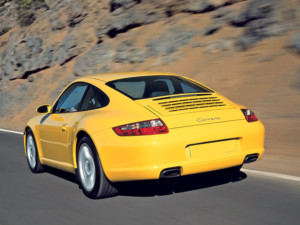 In our opinion, the Porsche 911 Carrera 997 is the first generation of the 911 water-cooled cars that really lived up to its promise. Where the air-cooled cars are rough and the 996 was raw, the 997 delivers a more sophisticated modern ride. Comfortable enough to be driven every day, but equally at home at a track day.
In our opinion, the Porsche 911 Carrera 997 is the first generation of the 911 water-cooled cars that really lived up to its promise. Where the air-cooled cars are rough and the 996 was raw, the 997 delivers a more sophisticated modern ride. Comfortable enough to be driven every day, but equally at home at a track day.
All generations of the 997 are easy to drive, park and have fun in. The ride quality and handling improved through the versions, but even the original 997 is nimble and lots of fun to drive. The revised looks, more sophisticated cabin and improved suspension all add up to a great car and are a world away from the original 996 for example.
The 997 range includes all of the usual suspects from the standard Carrera through the 2S, 4, 4S, Targa, Cabriolet, etc. The Targa version is essentially all glass from windshield to trunk, with the cabin section of the roof removable. In a slight twist, the rear section also acted as a tailgate that opens. The result is a very bright and light feeling cabin area, while on the outside, the Targa is very pretty.
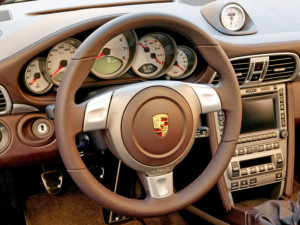 The 997 needs large N rated tires. If the car you buy has 19-inch rims, you'll be looking north of $1k for a decent set of 4 tires. The rear tires will wear quicker than the fronts on the 997 due to suspension setup. It's really important to stay on top of vehicle alignment – any loss of alignment on the rear of the 997 will eat the inner shoulder of the rear tire rapidly. This is difficult to see because it's so far under the car, but check it regularly or you'll be buying rear tires way more often than you expect.
The 997 needs large N rated tires. If the car you buy has 19-inch rims, you'll be looking north of $1k for a decent set of 4 tires. The rear tires will wear quicker than the fronts on the 997 due to suspension setup. It's really important to stay on top of vehicle alignment – any loss of alignment on the rear of the 997 will eat the inner shoulder of the rear tire rapidly. This is difficult to see because it's so far under the car, but check it regularly or you'll be buying rear tires way more often than you expect.
If your ownership plans include heading out for a track day (HPDE), then the 997 can be a lot of fun. On track, the car is easy to drive quickly and significantly more forgiving than the previous 996 version. Of course, like any good 911, it will swap ends on you at a certain point! However, the 997 communicates better with the driver and definitely provides more feedback and warning of driver over enthusiasm. Really pushing the 997 to the limit on track requires skill and a large set of gentlemen's attachments!
What Would We Buy?
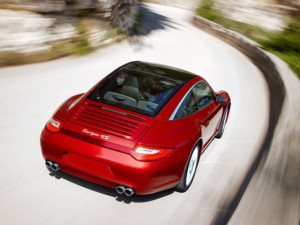 For us, if the price doesn't matter and you can find one (see missing years above), the 997 Carrera that has a little of everything you want, is the 997.2 Targa 4S version. Wide body, removable hard top, pretty, bright cabin, fast and nimble around corners. The 2S version will definitely get you going into high speed corners fast, but the 4S might get you out of the same corner quicker.
For us, if the price doesn't matter and you can find one (see missing years above), the 997 Carrera that has a little of everything you want, is the 997.2 Targa 4S version. Wide body, removable hard top, pretty, bright cabin, fast and nimble around corners. The 2S version will definitely get you going into high speed corners fast, but the 4S might get you out of the same corner quicker.
The glass roof and style of the 997.2 Targa doesn't seem to age and looks right at home next to a 911 produced 10 years later. Porsche went a little mad with colors around this time and there are some greens, browns and pinky reds to be avoided. The Targa, in white with dark tinted windows and roof looks beautiful.
The very early production 997 brings with it some of the issues associated with the previous 996 – cylinder scoring, cracked liners and an IMS bearing. Obviously, Porsche must have decided they would use up the parts they had left for the early production cars, before switching to the M97 engine. So, when you are shopping the original cars, make sure you have clarity on exactly what is lurking under the engine cover. There are some M96-05 engines with serviceable IMS bearings.
However, this does present a real bargain opportunity. If you compare a 2005 997 with 2006 997 you'll find a 50% difference in price! OK, so the 2005 version has the riskier M96 engine, but you could literally save $25K on essentially the same car. That's enough savings to rebuild the M96 engine if it had problems and still save money on the 2006 car!
So, if you're in the market for buying a used Porsche 997 what should you be paying attention to before you commit to buy?
Potential Mechanical Issues – Here's What To Look Out For
Fault Codes and Over-Revs
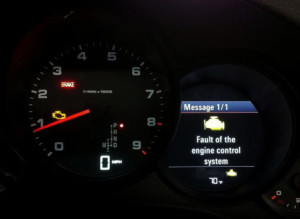 Before buying a 911 997, it is essential to know when the last time the system fault codes were cleared and check the status of the emission monitors. It's not difficult for a seller to clear the faults just before you arrive for a test drive. Clearing the engine faults also resets the emissions system to a state of "not ready." Emission readiness tests often occur over multiple drive cycles. So, after a reset, faults may not return for a significant number of miles. Again, this is easy for a competent repair shop to check or indeed the DIYer using a handheld scanner.
Before buying a 911 997, it is essential to know when the last time the system fault codes were cleared and check the status of the emission monitors. It's not difficult for a seller to clear the faults just before you arrive for a test drive. Clearing the engine faults also resets the emissions system to a state of "not ready." Emission readiness tests often occur over multiple drive cycles. So, after a reset, faults may not return for a significant number of miles. Again, this is easy for a competent repair shop to check or indeed the DIYer using a handheld scanner.
It is essential to determining the health of the engine to be able to read this data.
How hard has the car been driven?
Taking the engine to the red line for RPM is a good thing, but going over the red line obviously can cause damage. A gear change at red line will actually cause the revs to increase slightly momentarily – nothing bad here. But, if you select the wrong gear, the engine revs to go way over the red line. This is the famous "miss-shift" that has caused many engine explosions.
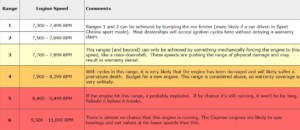 Thankfully, Porsche engine management records many things – one of the most significant is an over-rev situation. Data is permanently stored within the ECU showing running hours and when engine events have occurred. There are six levels of over-revs recorded ranging from the engine being red-lined through to what would be a potentially catastrophically high RPM event. Events in the first category suggests the car has been properly exercised, but events in the higher categories could be hiding a potential life shortening engine situation.
Thankfully, Porsche engine management records many things – one of the most significant is an over-rev situation. Data is permanently stored within the ECU showing running hours and when engine events have occurred. There are six levels of over-revs recorded ranging from the engine being red-lined through to what would be a potentially catastrophically high RPM event. Events in the first category suggests the car has been properly exercised, but events in the higher categories could be hiding a potential life shortening engine situation.
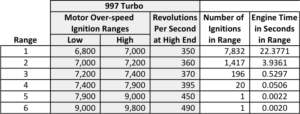 Many Porsche owners like to go to track days. On the track, gear changes will occur right around the rpm maximum red line. These events will be recorded if they reach the lower levels of the over rev counter. Multiple recorded events in the lower over-rev categories could be a sign of how much track time the car has experienced.
Many Porsche owners like to go to track days. On the track, gear changes will occur right around the rpm maximum red line. These events will be recorded if they reach the lower levels of the over rev counter. Multiple recorded events in the lower over-rev categories could be a sign of how much track time the car has experienced.
IMS Bearing – Early Production Cars
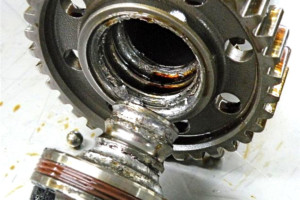 There's a lot of hype noise about the IMS bearing failure associated with Porsche engines. The majority of failures occurred on the M96 engine used in the 996 911 and 986 Boxster.
There's a lot of hype noise about the IMS bearing failure associated with Porsche engines. The majority of failures occurred on the M96 engine used in the 996 911 and 986 Boxster.
In general the 997 was shipped with the revised M96-05 and M97 engine that has an improved non-serviceable IMS bearing and does not suffer the failures associated with the earlier 996. There are however, some early M96-05 engines that do contain the serviceable IMS bearing that is more prone to failure.
These engines are restricted to the very early production cars usually in 2005 and 2006. Cars after that time have no known problems with the IMS until it was completely removed in the DFI engine from 2009 – worth checking the production date stamped on the driver door for clarity of the manufacturing date. If in doubt, use the vin number and talk to a friendly Porsche parts person. From the VIN, they should be able to clarify if the car had a serviceable or non serviceable bearing.
Overheating – Cracked Cylinder Liners 997.1
 Each cylinder bore in the engine case half is lined with a one-piece sleeve or liner. The M97 flat 6 engines fitted in the earlier 997 are subject to cracks in the liners of the cylinders.
Each cylinder bore in the engine case half is lined with a one-piece sleeve or liner. The M97 flat 6 engines fitted in the earlier 997 are subject to cracks in the liners of the cylinders.
Results from a crack vary, but typically the most common is coolant loss with subsequent engine overheating. Sometimes, a crack in the cylinder liner can take a considerable amount of running time to fully open and cause problems.
How to find out?
This is not an easy one because initially the coolant loss through this problem can be very slight. Also, tests when the car is cold do not reveal the problem – typically the crack in the liner only opens when the car is hot. It is a potential cause of some of the other problems, such as cylinder scoring, so it's worth paying time to identify this problem.
We strongly recommend seeking the guidance of an independent Porsche repair shop to help you through this process.
If you want to tackle it yourself, then this is a procedure that can shed some light on the issue. First, note the coolant level when the engine is cold. Take your time here – you want to drive the car for 30 mins. After driving the car, let it sit and idle for a while. The front radiator fans should come on and the engine should maintain a steady temp. If the engine continues to warm and will eventually overheat, walk away.
Assuming the engine holds a steady temperature, turn off and take a look at the coolant level – it should have risen and be falling back toward the cold level. If the level has gone down or is still at the cold level, there could be a small coolant loss through a cracked liner. The trained nose can smell coolant from the exhaust when the engine is running. A Porsche repair shop can definitely help here.
Note, this isn't a definitive test because you could be loosing coolant through an external system leak. However, any loss of coolant after a drive cycle should be thoroughly investigated.
Cylinder Scoring
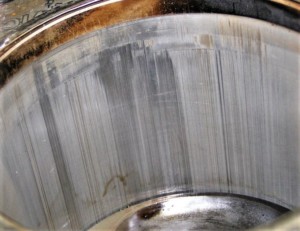 If you're considering buying an earlier 997, lift the car and have a listen from below while the engine is running. You might need a repair shop to do that for you. You'll hear the M97 flat 6 engine in the 997 make a consistent ticking sound.
If you're considering buying an earlier 997, lift the car and have a listen from below while the engine is running. You might need a repair shop to do that for you. You'll hear the M97 flat 6 engine in the 997 make a consistent ticking sound.
Much of this sound is the proximity of your ear to the valve train and the exhaust headers. However, there is a distinctly different sound that identifies with a particular issue that you don't want to hear.
The M97 engines are subject to cylinder scoring – deep gouges in the cylinder liner, usually associated with a knocking noise and eventually catastrophic engine failure. The root cause of this issue is open to discussion, however, wear in the piston rings and liners causes the piston to wobble. The wobble occurs at the bottom of the stroke and results in the piston skirt dragging against the cylinder wall thereby scoring the liner.
The sound your listening for is not a tick; it's a rhythmic knock and usually shows up first on the passenger bank of the flat 6 engines – although, it can appear on any cylinder. The rhythmic knock is the piston changing position at the bottom of the stroke and hitting the liner.
No Ticking – Early Signs
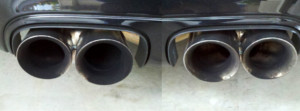 One of the potential early signs for significant engine problems is a mismatch in the sooty deposits inside the exhaust tailpipes. This clearly shows a difference in the running efficiency of one bank of cylinders versus the other and further investigation for the cause is necessary. A car with one black sooty tail pipe and one clean tail pipe is not a car to buy.
One of the potential early signs for significant engine problems is a mismatch in the sooty deposits inside the exhaust tailpipes. This clearly shows a difference in the running efficiency of one bank of cylinders versus the other and further investigation for the cause is necessary. A car with one black sooty tail pipe and one clean tail pipe is not a car to buy.
If you hear this noise and the price of the car is zero dollars, you'll still need approx. $20K to fix the problem!
Front Radiators and Air-Conditioning Condensers
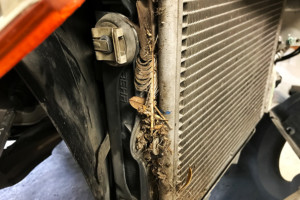 The design of the 997 has the placement of the coolant radiators and air-conditioning condensers low down in the front bumper. The position and open vent nature of the design, leaves them not only susceptible to stone impacts, but also to the buildup of debris and dirt stuck close to the radiators.
The design of the 997 has the placement of the coolant radiators and air-conditioning condensers low down in the front bumper. The position and open vent nature of the design, leaves them not only susceptible to stone impacts, but also to the buildup of debris and dirt stuck close to the radiators.
These front ducts and debris need to be cleaned out regularly or protected by an aftermarket screen. The front bumper has to be removed to reach the radiators and most owners never do it as part of regular service.
Take a flash light and look closely to see whether the front air intakes are full of rotting leaves and debris when you inspect the 997. Look closely, the debris will be around the sides of the radiators.
Damaged or corroded radiators and AC condensers cannot be repaired and must be replaced.
Suspension and Tires
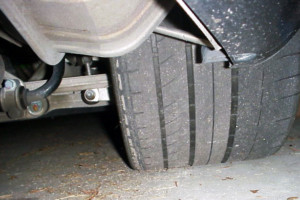 The suspension on the 997 is very reliable. The ride quality varies a little between the early versions and the later ones. Modifications to the design of the suspension for the release of the 997.2 made the car a little more subtle and better balanced.
The suspension on the 997 is very reliable. The ride quality varies a little between the early versions and the later ones. Modifications to the design of the suspension for the release of the 997.2 made the car a little more subtle and better balanced.
Naturally, over time wear can occur in plastic or rubber bushings that help to cushion the ride. Listen out for squeaks or clunks over bumps and check for leaks from the suspension struts.
Worn suspension components will typically show up as uneven tire wear. Check the tires thoroughly for smooth wear patterns. In particular, take a good look at the inside shoulders of the rear tires. Many owners miss this wear because it's so far under the car. Rear tires are not cheap to replace. The rear camber setting and wear in the rear control arms on the 911 can often produce excessive inside shoulder wear.
Also, pay attention to the tire DOT date on low mileage cars in particular. This is the date the tires were manufactured and is expressed in two numbers. For example, a DOT of 2413 means the tire was produced in the 24th week of 2013. You'll want to see a date that is no more than 5 years earlier. Low mileage cars in particular have this problem – the tires do not experience wear because of the lack of mileage. However, tires have a shelf life and will degrade while they sit – lots of tread doesn't always mean a healthy tire. A tire that is more than 5 years old could rapidly degrade or fail when you're driving, despite the amount of tread remaining.
Transmission – PDK
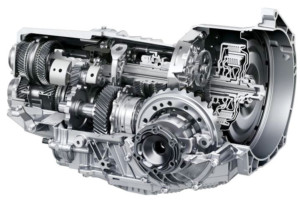 The later 997.2 features a Porsche-Doppelkupplungsgetriebe which translates to Porsche double-clutch transmission or PDK – now that's when you really need an acronym!
The later 997.2 features a Porsche-Doppelkupplungsgetriebe which translates to Porsche double-clutch transmission or PDK – now that's when you really need an acronym!
The PDK is an automated manual transmission. Two units matched together – a manual transmission rear section and automated dual clutch front section. The manual transmission rear section is very solid and reliable. Most issues occur with the electronic and hydraulically controlled clutch section at the front of the transmission.
Replacement of a PDK unit can run up to $15K, so it's well worth assessing the health of the PDK through a PPI before you buy. Checking history on the car should also reveal any work completed on the PDK. Check service history for fluid changes and software updates to be sure how well the PDk has been cared for.
The PDk is an excellent combination of automation and manual transmission qualities. Test driving, it should change gear quickly, sharply and smoothly. PDK equipped cars are usually quicker than manual cars due to the speed of gear change. If you thought you could never give up a manual trans sports car, the PDK transmission might change your mind. As for resale, less and less people these days have any idea that a third pedal exists, so the PDK might be the easier sell.
Brakes
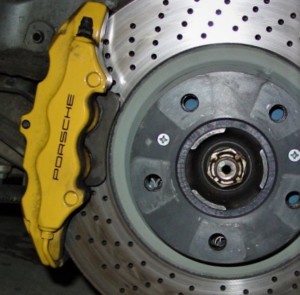 The brakes on the 997 are excellent. Brake pad material does degrade over time, so on low mileage examples check to see when the last brake service was performed. The brake fluid should be changed every few years regardless of mileage.
The brakes on the 997 are excellent. Brake pad material does degrade over time, so on low mileage examples check to see when the last brake service was performed. The brake fluid should be changed every few years regardless of mileage.
A complete brake service with pads, rotors and sensors can be quite expensive. So, if you're buying from a used car vendor, look for new pads on old rotors. Both the pads and rotors should always be changed at the same time.
There should be a wear lip on the rotor and the size of that lip will determine how much mileage remains. Worn rotors crack or disintegrate, which can be particularly unpleasant when driving!
The 997 came with drilled rotors. Look carefully to see how clear the holes are and make sure there are not cracks between the drill holes. Cracks between the drill holes can lead to a much bigger crack and rotor failure very quickly under heavy braking.
Porsche Ceramic Composite Brakes
The ceramic brake setup was a factory fitted option for the 997 and generally seen on the S, Turbo and GT models. Porsche Ceramic Composite Brakes (PCCB) use cross-drilled, carbon fiber reinforced ceramic discs with special composite pads. They produce amazing stopping power and are 50% lighter than a standard brake a setup. They also have a considerably longer life than their standard counterparts. However, the expected life of the PCC brakes does not always play out in reality, especially if the car has seen track time.
If you are buying a Porsche 911 997 that has the PCCB option, it's worth being certain how much life remains on the brakes. Parts for the front brakes alone could run you more than $10,000. Sounds like a good reason for selling a car!
Cabriolet Roof
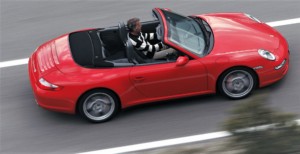 If you are buying a convertible, make sure you spend enough time checking the operation of the roof, to ensure it goes up and down smoothly. Many of the known problems with the opening & closing mechanism should have been resolved during the previous owner's time. Most of the top issues are usually simple and inexpensive to fix, but can be annoying if you only discover them when you want to drop the top on your first sunny day.
If you are buying a convertible, make sure you spend enough time checking the operation of the roof, to ensure it goes up and down smoothly. Many of the known problems with the opening & closing mechanism should have been resolved during the previous owner's time. Most of the top issues are usually simple and inexpensive to fix, but can be annoying if you only discover them when you want to drop the top on your first sunny day.
The top material does degrade over time. Replacement of the top is quite a common job for competent shops. The roof itself will be approx $1000 plus installation. If the top is seriously degraded, make this part of your price negotiation.
Importantly, look for signs of leaks from the roof into the cabin. Look behind the seats in particular. The rear roof drains can get blocked by leaves and debris over time. This results in rainwater dripping into an area of the cabin in which electronic control units are located. It is simple enough to keep the drains clear, but failing to do so can be an expensive and annoying oversight.
Rush Out and Pick One Up Today
The earlier 997 is a bargain for so much car – you can easily have a day out at the track and go out to dinner with it in the evening. The 997.1 comes with a little more risk than the 997.2 version, however, there are less of the later version available as new car sales had decreased significantly during it's production launch. Therefore, the 997.2 commands a little bit of a premium but comes with less of the potential problems.
Source: https://www.pcarwise.com/local-help/used-porsche-buyers-guide/buying-a-used-porsche-911-carrera-997/
 Reviewed by Admin
on
Desember 02, 2021
Rating:
Reviewed by Admin
on
Desember 02, 2021
Rating:


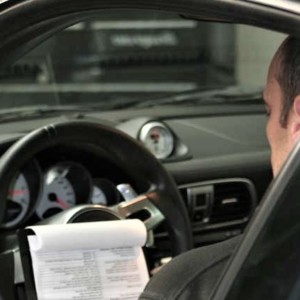






Tidak ada komentar: